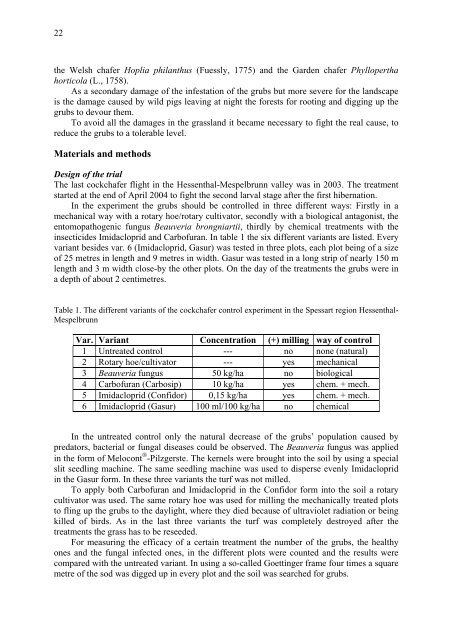IOBC/wprs Bulletin Vol. 28(2) 2005
IOBC/wprs Bulletin Vol. 28(2) 2005
IOBC/wprs Bulletin Vol. 28(2) 2005
You also want an ePaper? Increase the reach of your titles
YUMPU automatically turns print PDFs into web optimized ePapers that Google loves.
22<br />
the Welsh chafer Hoplia philanthus (Fuessly, 1775) and the Garden chafer Phyllopertha<br />
horticola (L., 1758).<br />
As a secondary damage of the infestation of the grubs but more severe for the landscape<br />
is the damage caused by wild pigs leaving at night the forests for rooting and digging up the<br />
grubs to devour them.<br />
To avoid all the damages in the grassland it became necessary to fight the real cause, to<br />
reduce the grubs to a tolerable level.<br />
Materials and methods<br />
Design of the trial<br />
The last cockchafer flight in the Hessenthal-Mespelbrunn valley was in 2003. The treatment<br />
started at the end of April 2004 to fight the second larval stage after the first hibernation.<br />
In the experiment the grubs should be controlled in three different ways: Firstly in a<br />
mechanical way with a rotary hoe/rotary cultivator, secondly with a biological antagonist, the<br />
entomopathogenic fungus Beauveria brongniartii, thirdly by chemical treatments with the<br />
insecticides Imidacloprid and Carbofuran. In table 1 the six different variants are listed. Every<br />
variant besides var. 6 (Imidacloprid, Gasur) was tested in three plots, each plot being of a size<br />
of 25 metres in length and 9 metres in width. Gasur was tested in a long strip of nearly 150 m<br />
length and 3 m width close-by the other plots. On the day of the treatments the grubs were in<br />
a depth of about 2 centimetres.<br />
Table 1. The different variants of the cockchafer control experiment in the Spessart region Hessenthal-<br />
Mespelbrunn<br />
Var. Variant Concentration (+) milling way of control<br />
1 Untreated control --- no none (natural)<br />
2 Rotary hoe/cultivator --- yes mechanical<br />
3 Beauveria fungus 50 kg/ha no biological<br />
4 Carbofuran (Carbosip) 10 kg/ha yes chem. + mech.<br />
5 Imidacloprid (Confidor) 0,15 kg/ha yes chem. + mech.<br />
6 Imidacloprid (Gasur) 100 ml/100 kg/ha no chemical<br />
In the untreated control only the natural decrease of the grubs’ population caused by<br />
predators, bacterial or fungal diseases could be observed. The Beauveria fungus was applied<br />
in the form of Melocont ® -Pilzgerste. The kernels were brought into the soil by using a special<br />
slit seedling machine. The same seedling machine was used to disperse evenly Imidacloprid<br />
in the Gasur form. In these three variants the turf was not milled.<br />
To apply both Carbofuran and Imidacloprid in the Confidor form into the soil a rotary<br />
cultivator was used. The same rotary hoe was used for milling the mechanically treated plots<br />
to fling up the grubs to the daylight, where they died because of ultraviolet radiation or being<br />
killed of birds. As in the last three variants the turf was completely destroyed after the<br />
treatments the grass has to be reseeded.<br />
For measuring the efficacy of a certain treatment the number of the grubs, the healthy<br />
ones and the fungal infected ones, in the different plots were counted and the results were<br />
compared with the untreated variant. In using a so-called Goettinger frame four times a square<br />
metre of the sod was digged up in every plot and the soil was searched for grubs.

















